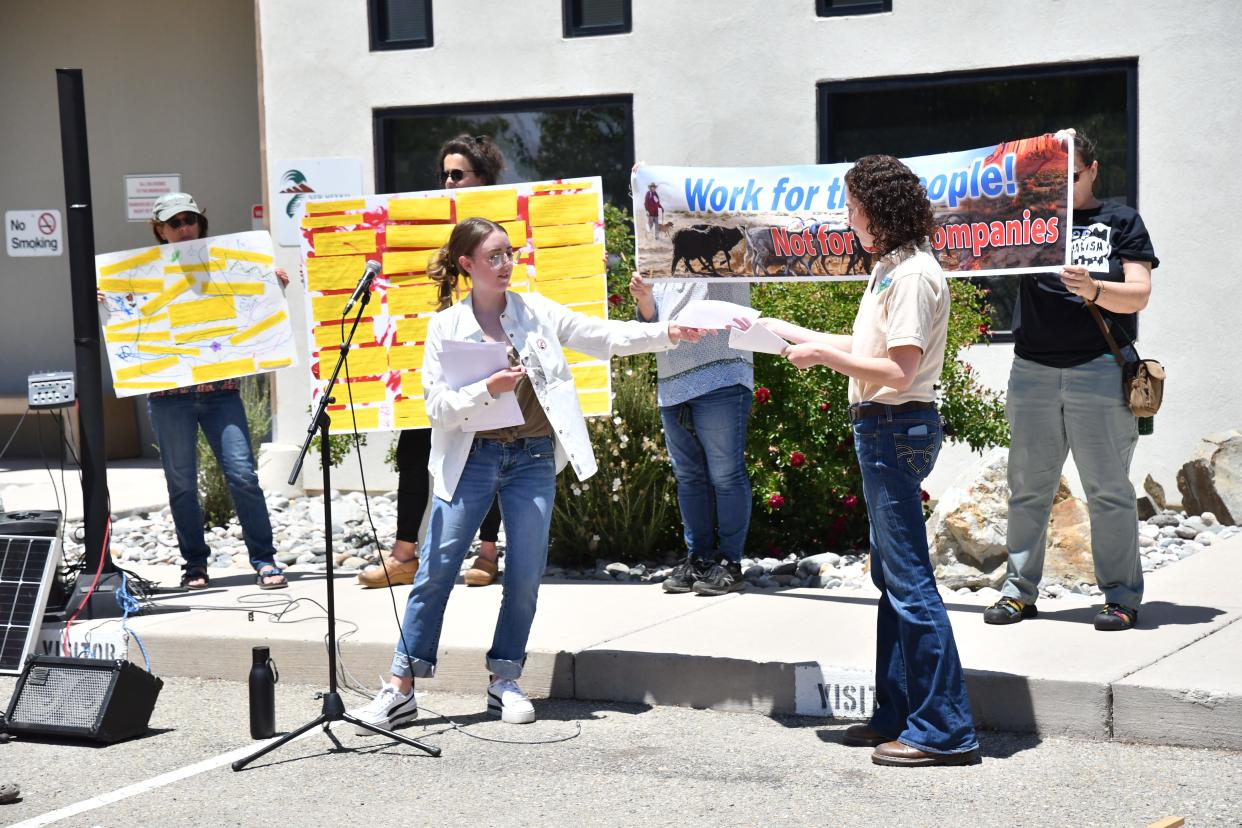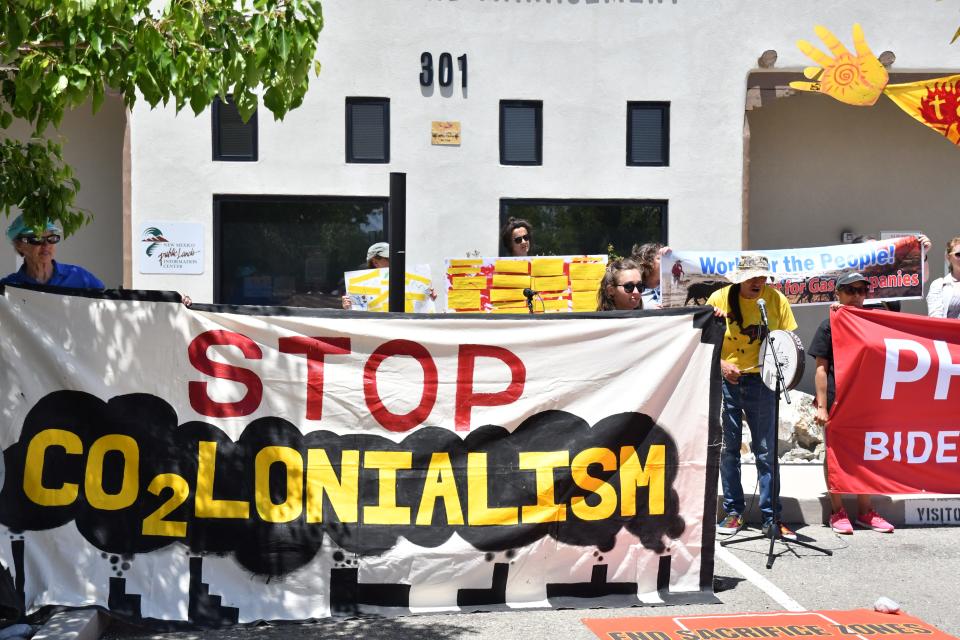Oil and gas land sale nets $79M. New Mexico environmental groups fear climate impacts

A contentious auction of public land to the oil and gas industry brought in about $78.8 million to the federal government this week, amid outcry from New Mexico environmental groups calling for a halt on using the lands for fossil fuel drilling.
The Bureau of Land Management offered 10,123 acres on 45 parcels in southeast New Mexico in Eddy, Lea and Chaves and in Cheyenne County, Kansas in the sale.
In total, the agency told 37 of the parcels, totaling in 8,596 acres that can now be used by energy companies to produce oil and gas.
More: Oil and gas 'done right' means higher costs for New Mexico operators, study says
The leases last 10 years or as long as fossil fuels are produced.
There were 3,279 acres sold in New Mexico and 5,316 sold in Kansas.
While there were more acres sold in Kansas, the Permian Basin acreage sale resulted in $78.7 million in total revenue compared to about $90,000 in Cheyenne County.
More: New Mexico leaders want to block oil and gas on some public lands. Feds consider proposal
The most revenue produced by any parcel in the sale was $16.2 million brought in by a lease of 280 acres in Eddy County to Devon Energy, followed by two leases to Federal Abstract Company for a 240-acre parsel in Lea County and a 320-acre parcel in Eddy County expected to generate $10.1 million and $10 million, respectively.
The next-most revenue from a lease sold at the auction was $8.1 million coming from the lease of a 320-acre parcel in Lea County to Promontory Exploration.
The most lucrative parcels in Kansas were two 560-acre parcels in Cheyenne County, each sold for $7,465, to Murffin Drilling Company.
More: Protests rally ahead of federal oil and gas lease sale in southeast New Mexico

Sale spurs debate in New Mexico on fossil fuel's climate change impacts
Despite millions in revenue generated from the sale, it drew the ire of New Mexico environmental groups who in the days leading up to the sale delivered letters to the BLM’s local offices throughout the state, demanding the agency cancel the leases.
An environmental analysis filed by the BLM in advance of the sale noted operations on the lands offered would alone have "no significant impact" on pollution in the region.
But Kayley Shoup of Citizens Caring for the Future, which led the Carlsbad protest, said the economic benefits were coming at the expense of human health and the environment.
More: $141M Permian Basin oil and gas deal finalized as more companies move into region
The Permian Basin, where Carlsbad is centered, is the busiest oil and gas field in the U.S., forecast to produce about 5.7 million barrels of oil per day (bpd) in June, according to the Energy Information Administration, after a growth of 15,000 bpd by the end of this month.
Shoup said that growth was imperiling her community and those in southeast New Mexico that dwell alongside fossil fuel operations.
“Not only does oil and gas production in the Permian have a profound impact on the climate, but it also greatly affects public and environmental health in the region,” she said. “I fear we have no idea just how contaminated our water, land and therefore our bodies may be by these highly toxic and health harming fracking chemicals. It’s shameful that our health and well-being are up for sale.”
More: Oil industry buying more public land in New Mexico. Feds hope to prioritize conservation
Rebeca Sobel with Santa Fe-based WildEarth Guardians said oil and gas production must be stopped as she argued it exacerbates climate change by polluting the air and water in New Mexico and across the nation.
Sobel said organizations would continue fighting federal use of public land for the industry, both through demonstrations and litigation.
“Every new well drilled is another nail in the coffin, and communities cannot afford to wait for an end to the destruction of our clean air, clean water, and healthy lands,” she said. “In the courts and in the streets, the calls to end the era of fossil fuels are resounding.”
More: $540M oil and gas deal in Permian Basin latest of fossil fuel investments in region
New Mexico’s northwest natural gas fields in the San Juan Basin region are surrounded by lands sacred to the Navajo Nation in Chaco Canyon, said Julia Bernal, executive director of the Pueblo Action Alliance.
She said continued extraction was damaging to indigenous communities and their relationships to the land, which should be better considered in federal land management decisions.
“Many Indigenous nations in New Mexico have cultural connections and relationships with lands being sacrificed to oil and gas, like the Greater Chaco landscape, when they have stewarded these ancestral lands since time immemorial,” Bernal said.
“It is imperative that Indigenous people and their knowledge of the landscape be centered in land management decisions to address the oil and gas industry, the global climate crisis, and to ensure better land and water practices that absorb the shock of climate change, but this collaboration has yet to occur.”
More: Oil and gas sends $16B to New Mexico's economy, industry reports. Health concerns linger
In the face of pressure from environmental and government organizations to reduce its impact on climate change, oil and gas industry leaders recently put goals in place to reduce emissions and their environmental footprint.
In its 2023 progress report, ExxonMobil − one of the Permian's largest operators − said it intended to invest $17 billion in lowering emissions through 2027, reporting the company already reduced methane releases by more than 50 percent in 2022, compared to 2016 levels.
In a letter from Chief Executive Officer Darren Woods, he said ExxonMobil remained committed to help the world transition to less-pollutive energy production while continuing to meet the demand he said could only be satisfied by fossil fuels.
“For too long, the conventional wisdom about ExxonMobil was that we had to make a choice to either meet the world’s energy needs or play a leading role in the energy transition. That view has always been flawed,” Woods wrote in a letter accompanying the progress report.
“The fact is, it is an ‘and’ equation – one in which we can produce the products societies need and lead in reducing greenhouse gas emissions, both our own and others.”
Adrian Hedden can be reached at 575-628-5516, achedden@currentargus.com or @AdrianHedden on Twitter.
This article originally appeared on Carlsbad Current-Argus: Oil and gas land sale nets $79M amid New Mexico climate concerns

